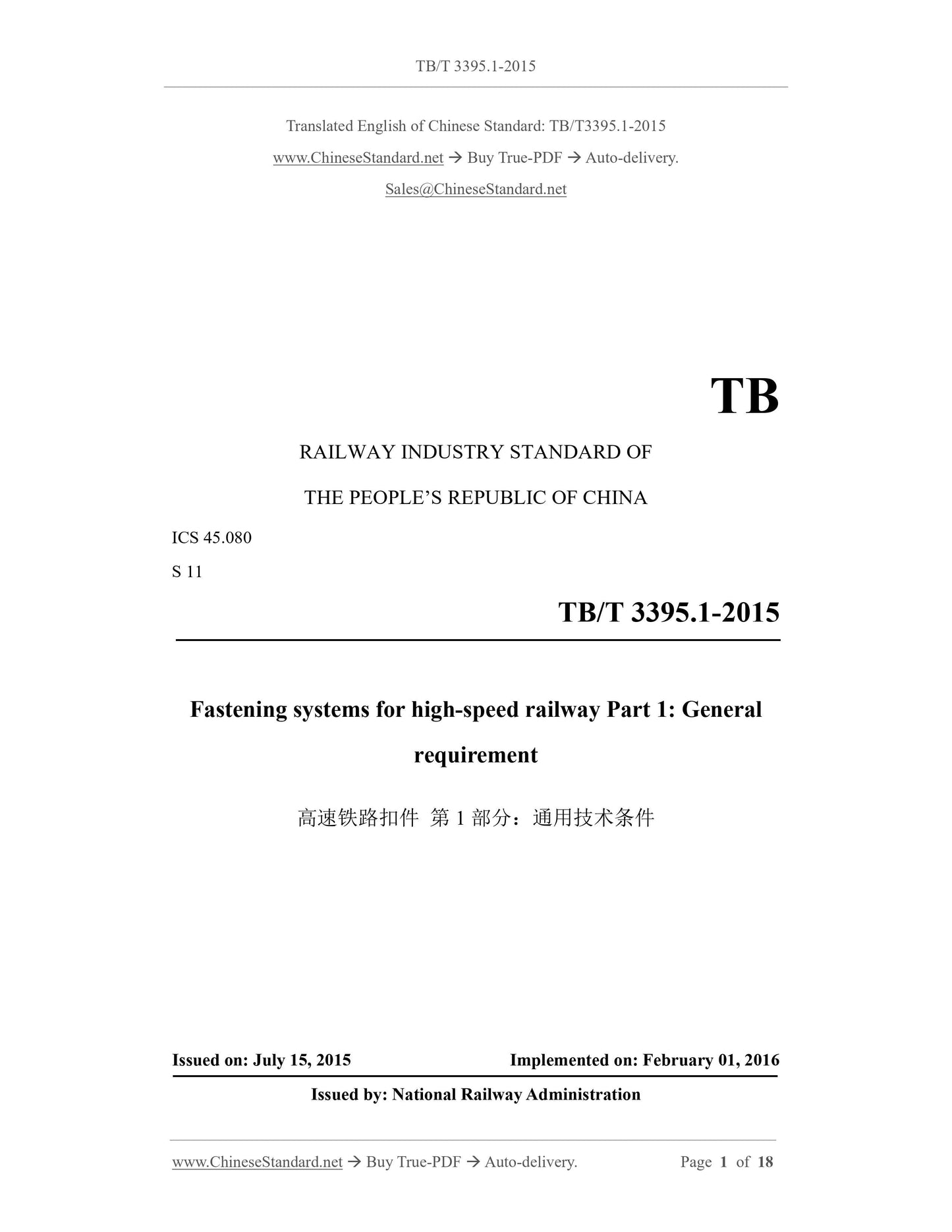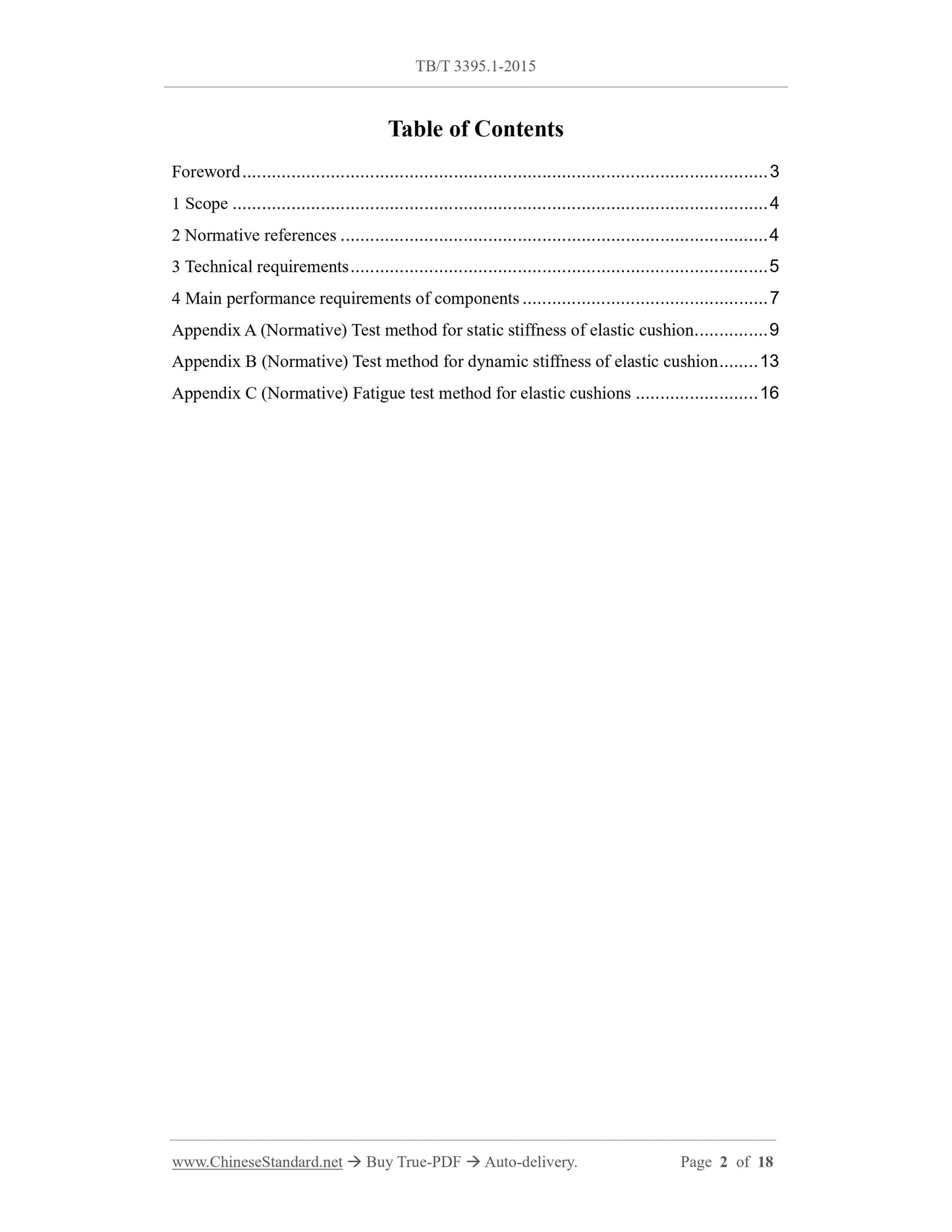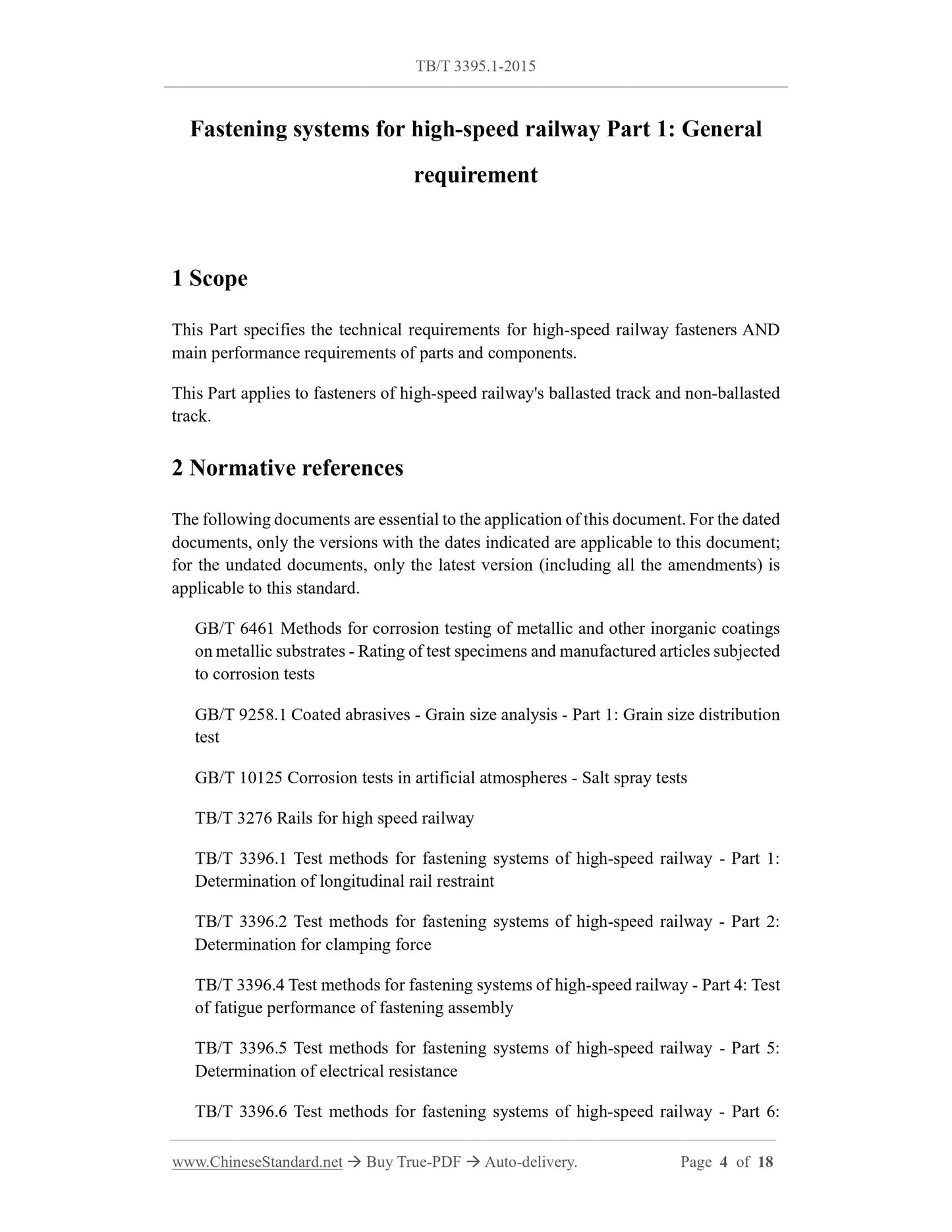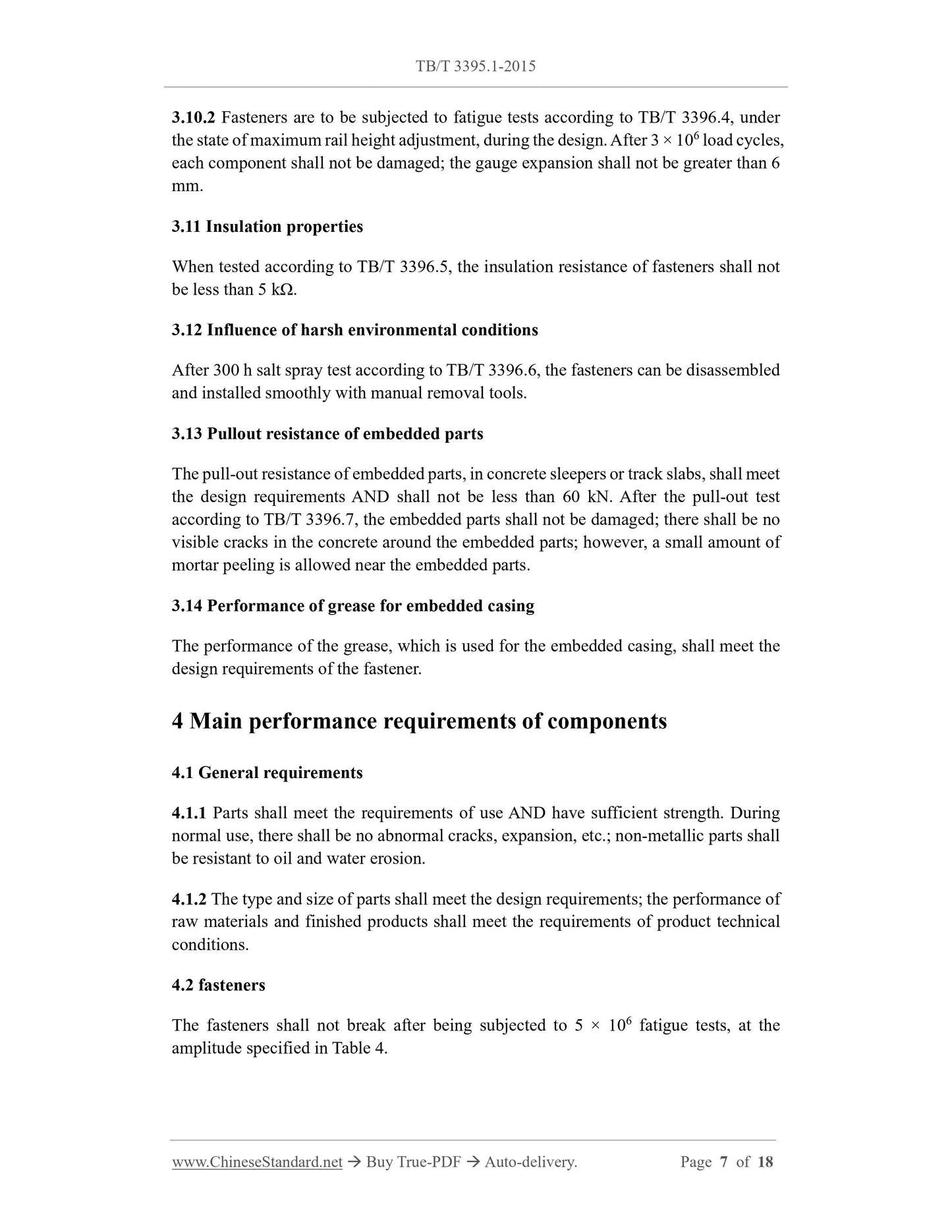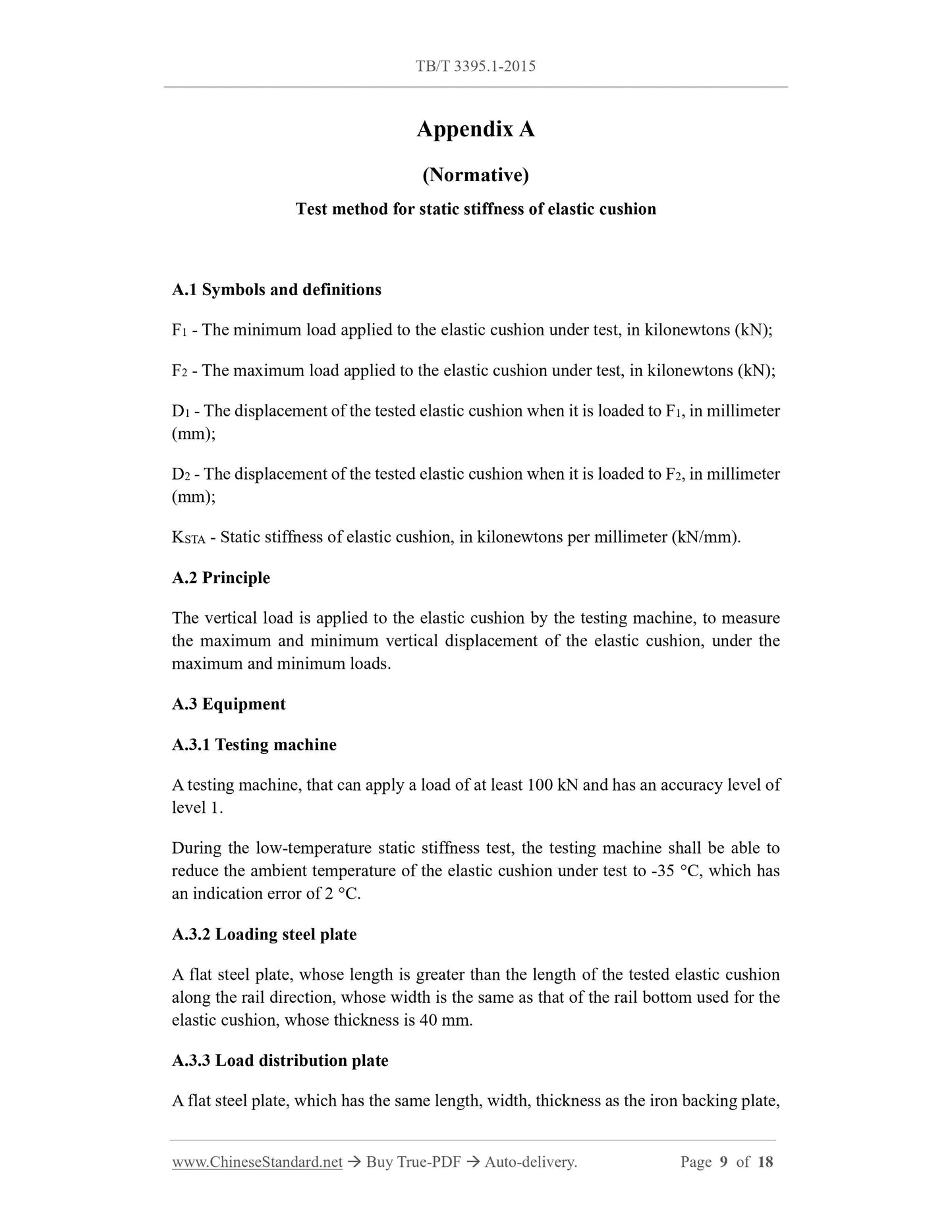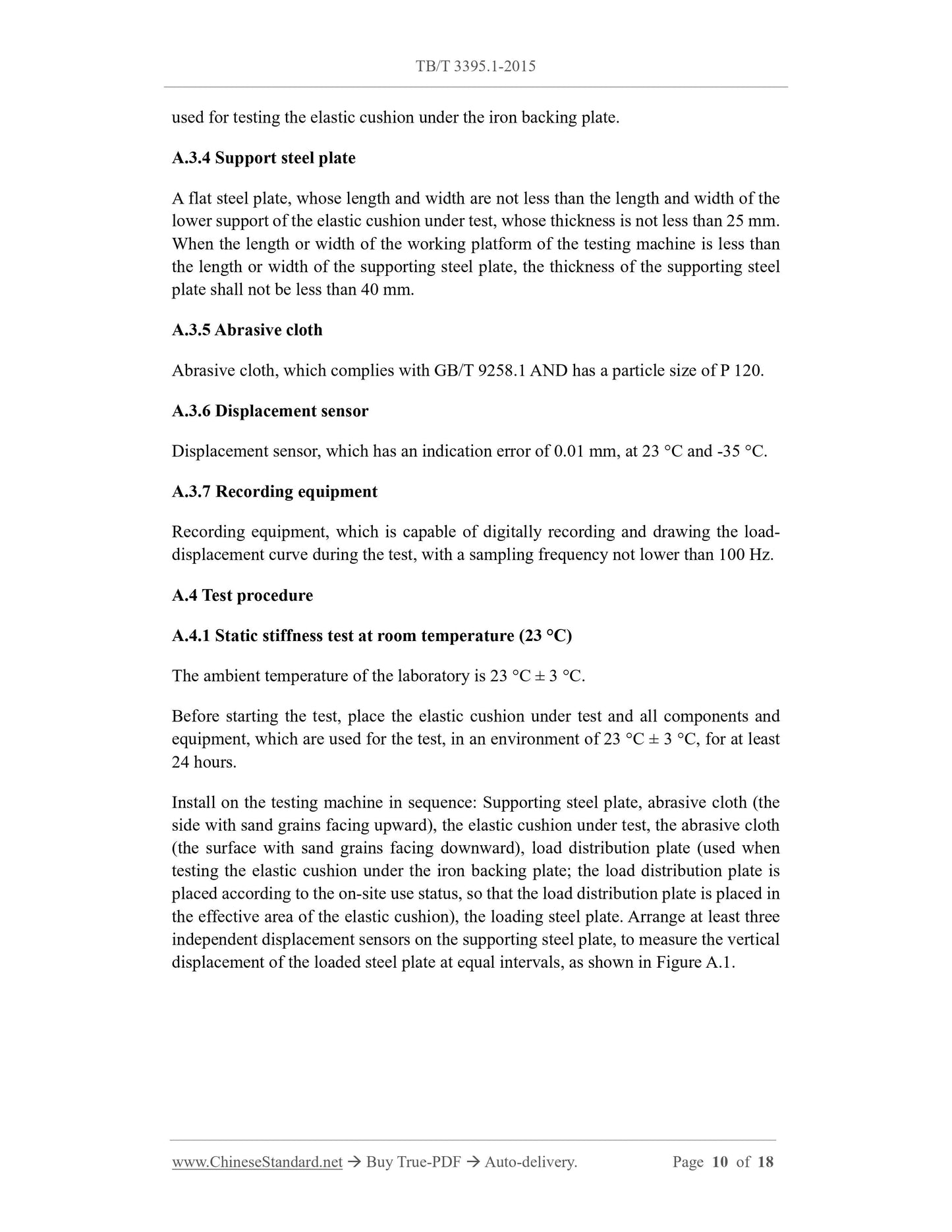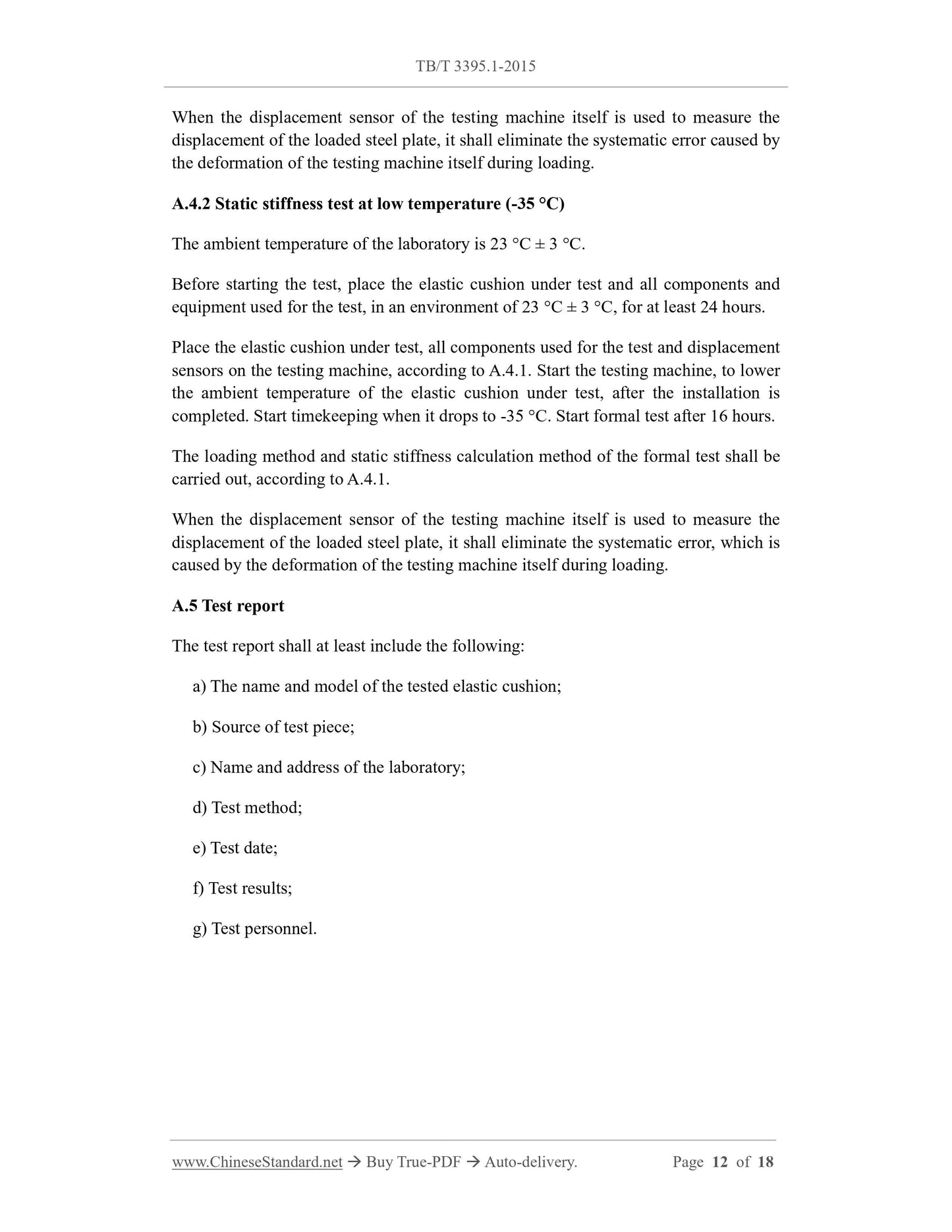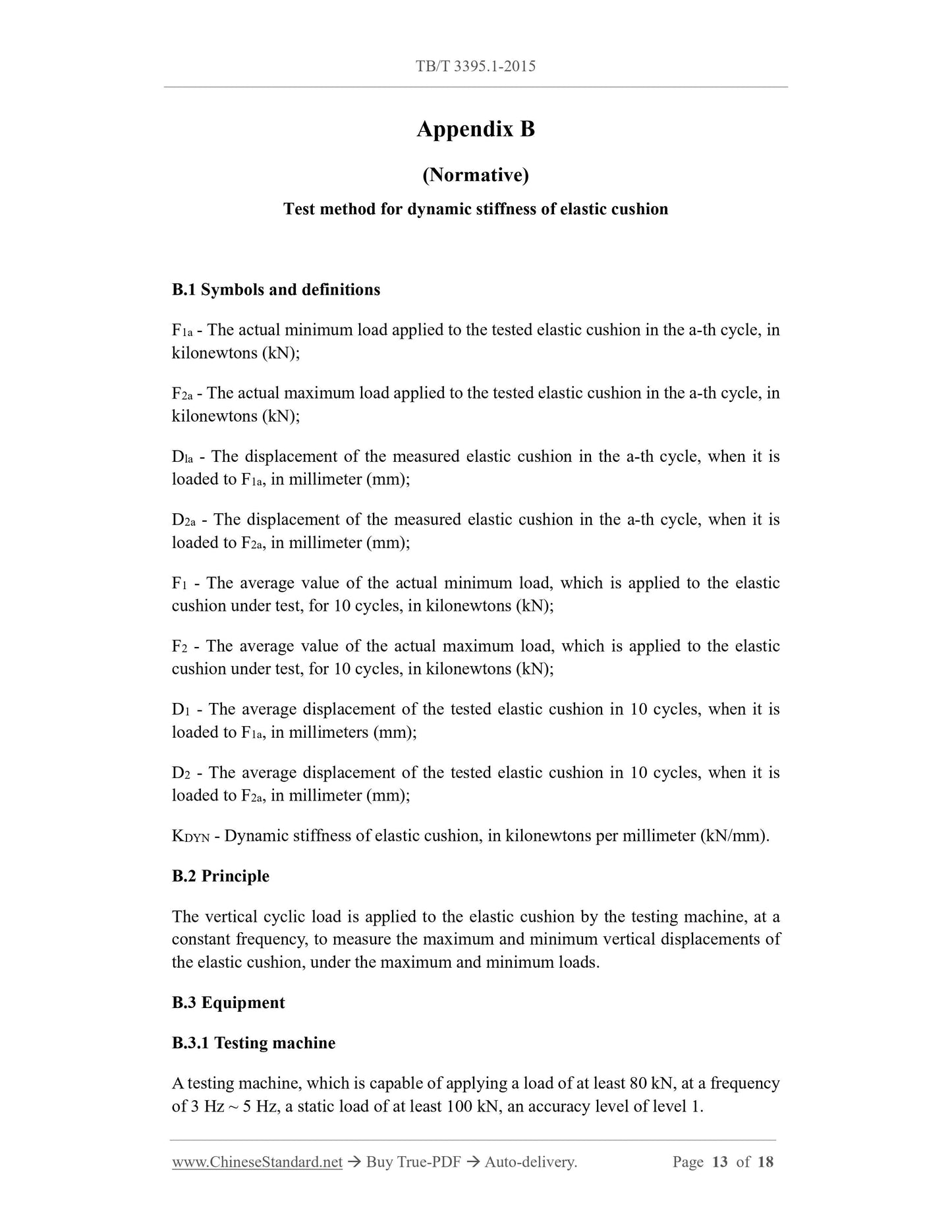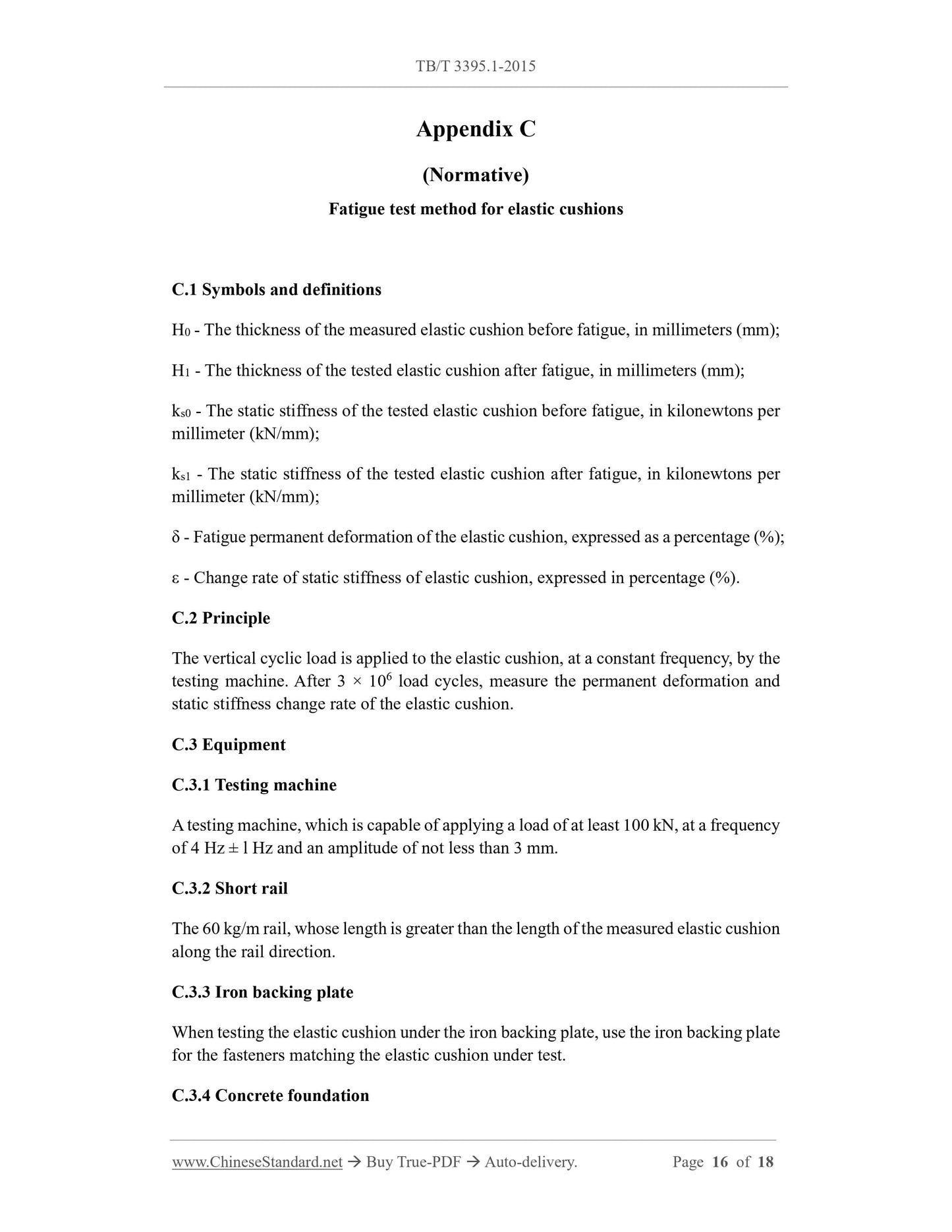1
/
/
9
PayPal, credit cards. Download editable-PDF and invoice in 1 second!
TB/T 3395.1-2015 English PDF (TBT3395.1-2015)
TB/T 3395.1-2015 English PDF (TBT3395.1-2015)
Normaalihinta
$290.00 USD
Normaalihinta
Alennushinta
$290.00 USD
Yksikköhinta
/
kohti
Toimituskulut lasketaan kassalla.
Noudon saatavuutta ei voitu ladata
Delivery: 3 seconds. Download true-PDF + Invoice.
Get QUOTATION in 1-minute: Click TB/T 3395.1-2015
Historical versions: TB/T 3395.1-2015
Preview True-PDF (Reload/Scroll if blank)
TB/T 3395.1-2015: Fastening systems for high-speed railway Part 1: General requirement
TB/T 3395.1-2015
TB
RAILWAY INDUSTRY STANDARD OF
THE PEOPLE’S REPUBLIC OF CHINA
ICS 45.080
S 11
Fastening systems for high-speed railway Part 1: General
requirement
ISSUED ON: JULY 15, 2015
IMPLEMENTED ON: FEBRUARY 01, 2016
Issued by: National Railway Administration
Table of Contents
Foreword ... 3
1 Scope ... 4
2 Normative references ... 4
3 Technical requirements ... 5
4 Main performance requirements of components ... 7
Appendix A (Normative) Test method for static stiffness of elastic cushion ... 9
Appendix B (Normative) Test method for dynamic stiffness of elastic cushion ... 13
Appendix C (Normative) Fatigue test method for elastic cushions ... 16
Fastening systems for high-speed railway Part 1: General
requirement
1 Scope
This Part specifies the technical requirements for high-speed railway fasteners AND
main performance requirements of parts and components.
This Part applies to fasteners of high-speed railway's ballasted track and non-ballasted
track.
2 Normative references
The following documents are essential to the application of this document. For the dated
documents, only the versions with the dates indicated are applicable to this document;
for the undated documents, only the latest version (including all the amendments) is
applicable to this standard.
GB/T 6461 Methods for corrosion testing of metallic and other inorganic coatings
on metallic substrates - Rating of test specimens and manufactured articles subjected
to corrosion tests
GB/T 9258.1 Coated abrasives - Grain size analysis - Part 1: Grain size distribution
test
GB/T 10125 Corrosion tests in artificial atmospheres - Salt spray tests
TB/T 3276 Rails for high speed railway
TB/T 3396.1 Test methods for fastening systems of high-speed railway - Part 1:
Determination of longitudinal rail restraint
TB/T 3396.2 Test methods for fastening systems of high-speed railway - Part 2:
Determination for clamping force
TB/T 3396.4 Test methods for fastening systems of high-speed railway - Part 4: Test
of fatigue performance of fastening assembly
TB/T 3396.5 Test methods for fastening systems of high-speed railway - Part 5:
Determination of electrical resistance
TB/T 3396.6 Test methods for fastening systems of high-speed railway - Part 6:
3.10.2 Fasteners are to be subjected to fatigue tests according to TB/T 3396.4, under
the state of maximum rail height adjustment, during the design. After 3 × 106 load cycles,
each component shall not be damaged; the gauge expansion shall not be greater than 6
mm.
3.11 Insulation properties
When tested according to TB/T 3396.5, the insulation resistance of fasteners shall not
be less than 5 kΩ.
3.12 Influence of harsh environmental conditions
After 300 h salt spray test according to TB/T 3396.6, the fasteners can be disassembled
and installed smoothly with manual removal tools.
3.13 Pullout resistance of embedded parts
The pull-out resistance of embedded parts, in concrete sleepers or track slabs, shall meet
the design requirements AND shall not be less than 60 kN. After the pull-out test
according to TB/T 3396.7, the embedded parts shall not be damaged; there shall be no
visible cracks in the concrete around the embedded parts; however, a small amount of
mortar peeling is allowed near the embedded parts.
3.14 Performance of grease for embedded casing
The performance of the grease, which is used for the embedded casing, shall meet the
design requirements of the fastener.
4 Main performance requirements of components
4.1 General requirements
4.1.1 Parts shall meet the requirements of use AND have sufficient strength. During
normal use, there shall be no abnormal cracks, expansion, etc.; non-metallic parts shall
be resistant to oil and water erosion.
4.1.2 The type and size of parts shall meet the design requirements; the performance of
raw materials and finished products shall meet the requirements of product technical
conditions.
4.2 fasteners
The fasteners shall not break after being subjected to 5 × 106 fatigue tests, at the
amplitude specified in Table 4.
Appendix A
(Normative)
Test method for static stiffness of elastic cushion
A.1 Symbols and definitions
F1 - The minimum load applied to the elastic cushion under test, in kilonewtons (kN);
F2 - The maximum load applied to the elastic cushion under test, in kilonewtons (kN);
D1 - The displacement of the tested elastic cushion when it is loaded to F1, in millimeter
(mm);
D2 - The displacement of the tested elastic cushion when it is loaded to F2, in millimeter
(mm);
KSTA - Static stiffness of elastic cushion, in kilonewtons per millimeter (kN/mm).
A.2 Principle
The vertical load is applied to the elastic cushion by the testing machine, to measure
the maximum and minimum vertical displacement of the elastic cushion, under the
maximum and minimum loads.
A.3 Equipment
A.3.1 Testing machine
A testing machine, that can apply a load of at least 100 kN and has an accuracy level of
level 1.
During the low-temperature static stiffness test, the testing machine shall be able to
reduce the ambient temperature of the elastic cushion under test to -35 °C, which has
an indication error of 2 °C.
A.3.2 Loading steel plate
A flat steel plate, whose length is greater than the length of the tested elastic cushion
along the rail direction, whose width is the same as that of the rail bottom used for the
elastic cushion, whose thickness is 40 mm.
A.3.3 Load distribution plate
A flat steel plate, which has the same length, width, thickness as the iron backing plate,
used for testing the elastic cushion under the iron backing plate.
A.3.4 Support steel plate
A flat steel plate, whose length and width are not less than the length and width of the
lower support of the elastic cushion under test, whose thickness is not less than 25 mm.
When the length or width of the working platform of the testing machine is less than
the length or width of the supporting steel plate, the thickness of the supporting steel
plate shall not be less than 40 mm.
A.3.5 Abrasive cloth
Abrasive cloth, which complies with GB/T 9258.1 AND has a particle size of P 120.
A.3.6 Displacement sensor
Displacement sensor, which has an indication error of 0.01 mm, at 23 °C and -35 °C.
A.3.7 Recording equipment
Recording equipment, which is capable of digitally recording and drawing the load-
displacement curve during the test, with a sampling frequency not lower than 100 Hz.
A.4 Test procedure
A.4.1 Static stiffness test at room temperature (23 °C)
The ambient temperature of the laboratory is 23 °C ± 3 °C.
Before starting the test, place the elastic cushion under test and all components and
equipment, which are used for the test, in an environment of 23 °C ± 3 °C, for at least
24 hours.
Install on the testing machine in sequence: Supporting steel plate, abrasive cloth (the
side with sand grains facing upward), the elastic cushion under test, the abrasive cloth
(the surface with sand grains facing downward), load distribution plate (used when
testing the elastic cushion under the iron backing plate; the load distribution plate is
placed according to the on-site use status, so that the load distribution plate is placed in
the effective area of the elastic cushion), the loading steel plate. Arrange at least three
independent displacement sensors on the supporting steel plate, to measure the vertical
displacement of ...
Get QUOTATION in 1-minute: Click TB/T 3395.1-2015
Historical versions: TB/T 3395.1-2015
Preview True-PDF (Reload/Scroll if blank)
TB/T 3395.1-2015: Fastening systems for high-speed railway Part 1: General requirement
TB/T 3395.1-2015
TB
RAILWAY INDUSTRY STANDARD OF
THE PEOPLE’S REPUBLIC OF CHINA
ICS 45.080
S 11
Fastening systems for high-speed railway Part 1: General
requirement
ISSUED ON: JULY 15, 2015
IMPLEMENTED ON: FEBRUARY 01, 2016
Issued by: National Railway Administration
Table of Contents
Foreword ... 3
1 Scope ... 4
2 Normative references ... 4
3 Technical requirements ... 5
4 Main performance requirements of components ... 7
Appendix A (Normative) Test method for static stiffness of elastic cushion ... 9
Appendix B (Normative) Test method for dynamic stiffness of elastic cushion ... 13
Appendix C (Normative) Fatigue test method for elastic cushions ... 16
Fastening systems for high-speed railway Part 1: General
requirement
1 Scope
This Part specifies the technical requirements for high-speed railway fasteners AND
main performance requirements of parts and components.
This Part applies to fasteners of high-speed railway's ballasted track and non-ballasted
track.
2 Normative references
The following documents are essential to the application of this document. For the dated
documents, only the versions with the dates indicated are applicable to this document;
for the undated documents, only the latest version (including all the amendments) is
applicable to this standard.
GB/T 6461 Methods for corrosion testing of metallic and other inorganic coatings
on metallic substrates - Rating of test specimens and manufactured articles subjected
to corrosion tests
GB/T 9258.1 Coated abrasives - Grain size analysis - Part 1: Grain size distribution
test
GB/T 10125 Corrosion tests in artificial atmospheres - Salt spray tests
TB/T 3276 Rails for high speed railway
TB/T 3396.1 Test methods for fastening systems of high-speed railway - Part 1:
Determination of longitudinal rail restraint
TB/T 3396.2 Test methods for fastening systems of high-speed railway - Part 2:
Determination for clamping force
TB/T 3396.4 Test methods for fastening systems of high-speed railway - Part 4: Test
of fatigue performance of fastening assembly
TB/T 3396.5 Test methods for fastening systems of high-speed railway - Part 5:
Determination of electrical resistance
TB/T 3396.6 Test methods for fastening systems of high-speed railway - Part 6:
3.10.2 Fasteners are to be subjected to fatigue tests according to TB/T 3396.4, under
the state of maximum rail height adjustment, during the design. After 3 × 106 load cycles,
each component shall not be damaged; the gauge expansion shall not be greater than 6
mm.
3.11 Insulation properties
When tested according to TB/T 3396.5, the insulation resistance of fasteners shall not
be less than 5 kΩ.
3.12 Influence of harsh environmental conditions
After 300 h salt spray test according to TB/T 3396.6, the fasteners can be disassembled
and installed smoothly with manual removal tools.
3.13 Pullout resistance of embedded parts
The pull-out resistance of embedded parts, in concrete sleepers or track slabs, shall meet
the design requirements AND shall not be less than 60 kN. After the pull-out test
according to TB/T 3396.7, the embedded parts shall not be damaged; there shall be no
visible cracks in the concrete around the embedded parts; however, a small amount of
mortar peeling is allowed near the embedded parts.
3.14 Performance of grease for embedded casing
The performance of the grease, which is used for the embedded casing, shall meet the
design requirements of the fastener.
4 Main performance requirements of components
4.1 General requirements
4.1.1 Parts shall meet the requirements of use AND have sufficient strength. During
normal use, there shall be no abnormal cracks, expansion, etc.; non-metallic parts shall
be resistant to oil and water erosion.
4.1.2 The type and size of parts shall meet the design requirements; the performance of
raw materials and finished products shall meet the requirements of product technical
conditions.
4.2 fasteners
The fasteners shall not break after being subjected to 5 × 106 fatigue tests, at the
amplitude specified in Table 4.
Appendix A
(Normative)
Test method for static stiffness of elastic cushion
A.1 Symbols and definitions
F1 - The minimum load applied to the elastic cushion under test, in kilonewtons (kN);
F2 - The maximum load applied to the elastic cushion under test, in kilonewtons (kN);
D1 - The displacement of the tested elastic cushion when it is loaded to F1, in millimeter
(mm);
D2 - The displacement of the tested elastic cushion when it is loaded to F2, in millimeter
(mm);
KSTA - Static stiffness of elastic cushion, in kilonewtons per millimeter (kN/mm).
A.2 Principle
The vertical load is applied to the elastic cushion by the testing machine, to measure
the maximum and minimum vertical displacement of the elastic cushion, under the
maximum and minimum loads.
A.3 Equipment
A.3.1 Testing machine
A testing machine, that can apply a load of at least 100 kN and has an accuracy level of
level 1.
During the low-temperature static stiffness test, the testing machine shall be able to
reduce the ambient temperature of the elastic cushion under test to -35 °C, which has
an indication error of 2 °C.
A.3.2 Loading steel plate
A flat steel plate, whose length is greater than the length of the tested elastic cushion
along the rail direction, whose width is the same as that of the rail bottom used for the
elastic cushion, whose thickness is 40 mm.
A.3.3 Load distribution plate
A flat steel plate, which has the same length, width, thickness as the iron backing plate,
used for testing the elastic cushion under the iron backing plate.
A.3.4 Support steel plate
A flat steel plate, whose length and width are not less than the length and width of the
lower support of the elastic cushion under test, whose thickness is not less than 25 mm.
When the length or width of the working platform of the testing machine is less than
the length or width of the supporting steel plate, the thickness of the supporting steel
plate shall not be less than 40 mm.
A.3.5 Abrasive cloth
Abrasive cloth, which complies with GB/T 9258.1 AND has a particle size of P 120.
A.3.6 Displacement sensor
Displacement sensor, which has an indication error of 0.01 mm, at 23 °C and -35 °C.
A.3.7 Recording equipment
Recording equipment, which is capable of digitally recording and drawing the load-
displacement curve during the test, with a sampling frequency not lower than 100 Hz.
A.4 Test procedure
A.4.1 Static stiffness test at room temperature (23 °C)
The ambient temperature of the laboratory is 23 °C ± 3 °C.
Before starting the test, place the elastic cushion under test and all components and
equipment, which are used for the test, in an environment of 23 °C ± 3 °C, for at least
24 hours.
Install on the testing machine in sequence: Supporting steel plate, abrasive cloth (the
side with sand grains facing upward), the elastic cushion under test, the abrasive cloth
(the surface with sand grains facing downward), load distribution plate (used when
testing the elastic cushion under the iron backing plate; the load distribution plate is
placed according to the on-site use status, so that the load distribution plate is placed in
the effective area of the elastic cushion), the loading steel plate. Arrange at least three
independent displacement sensors on the supporting steel plate, to measure the vertical
displacement of ...
Share
